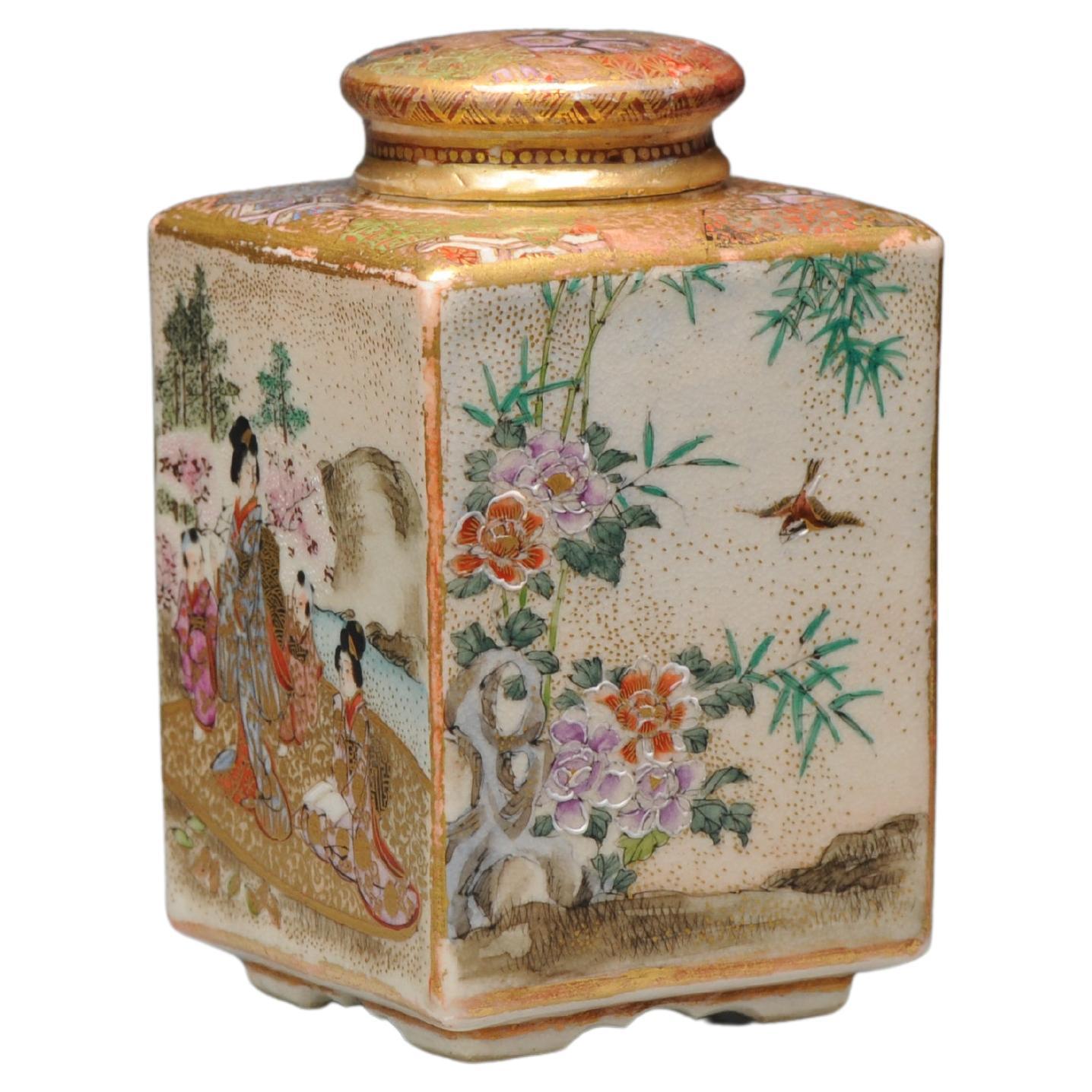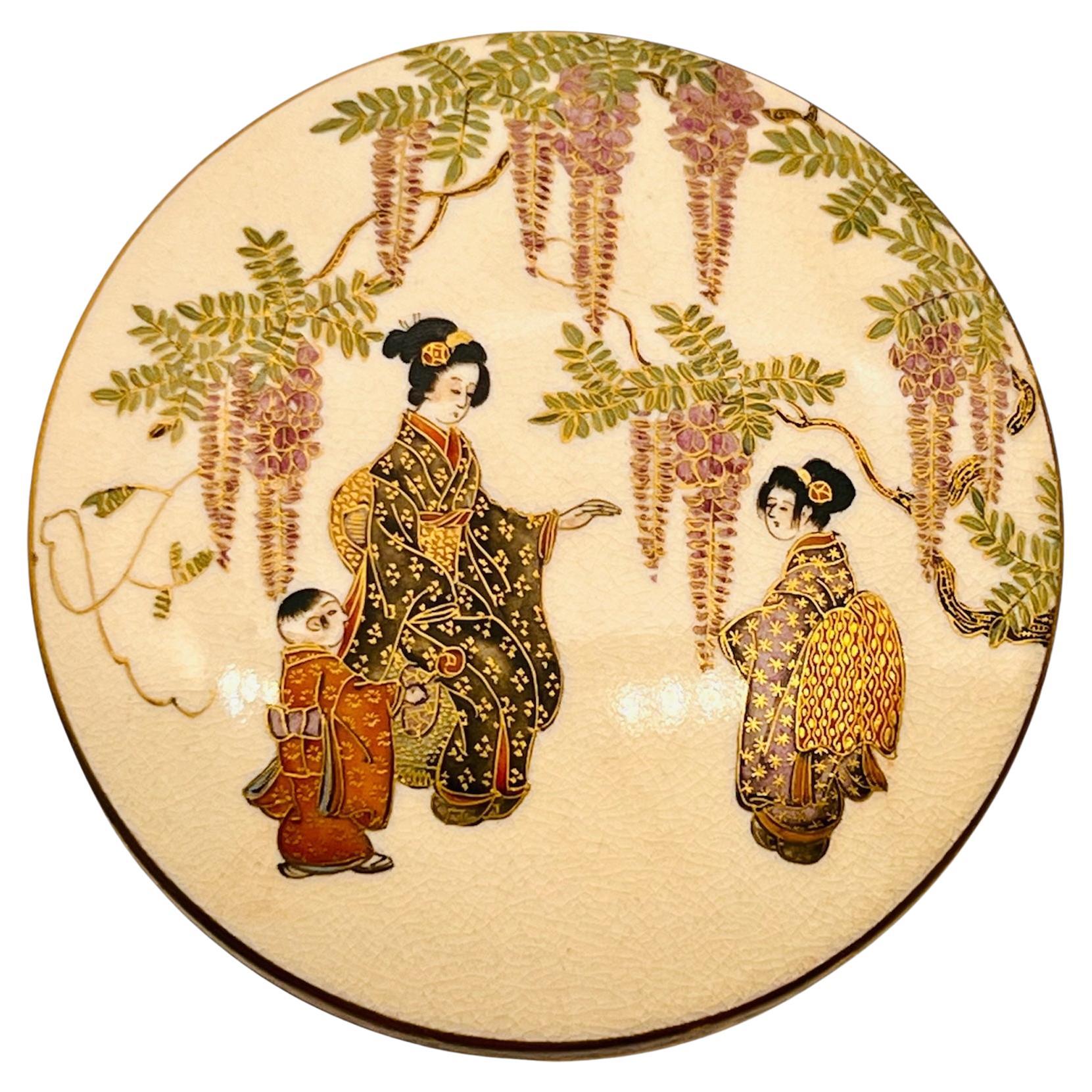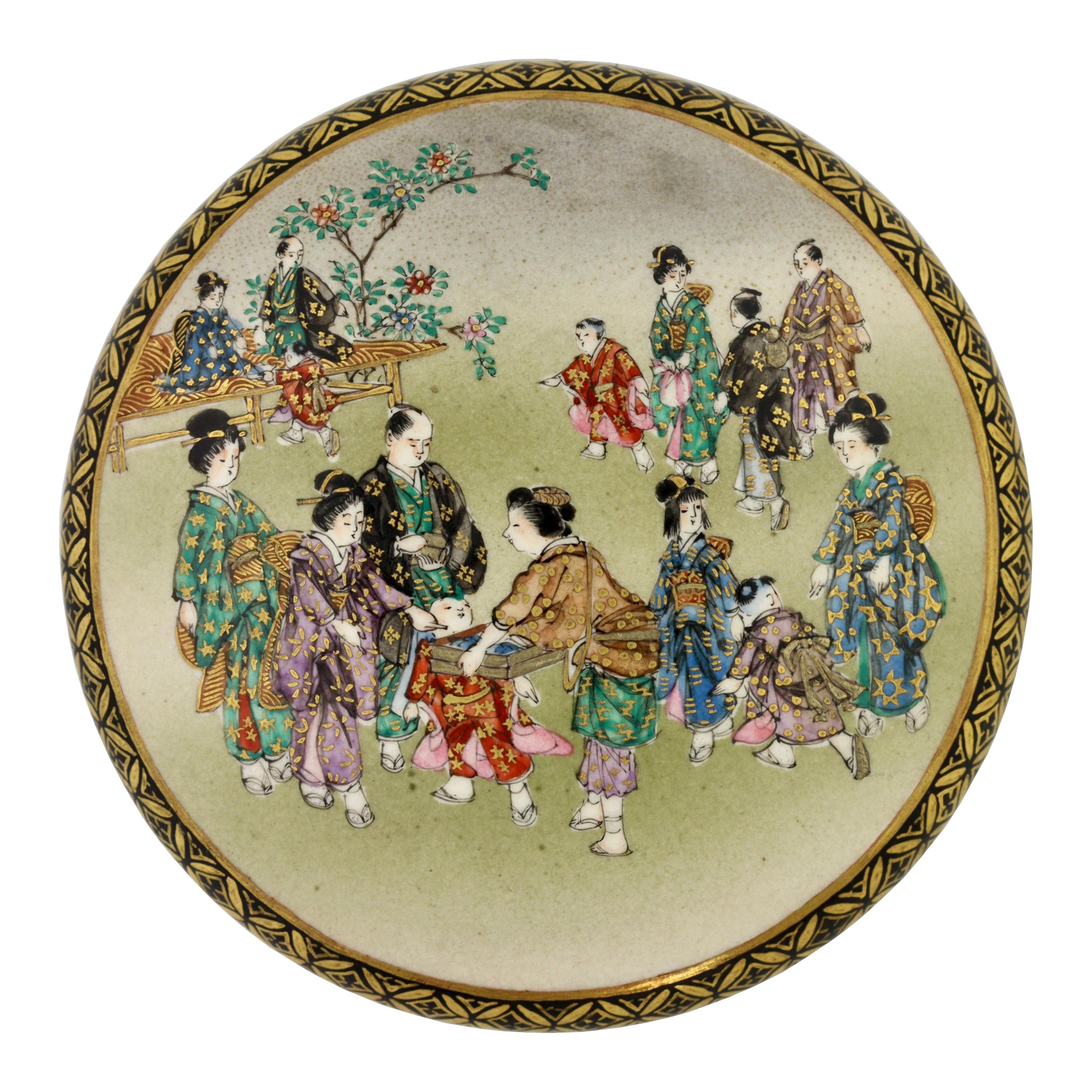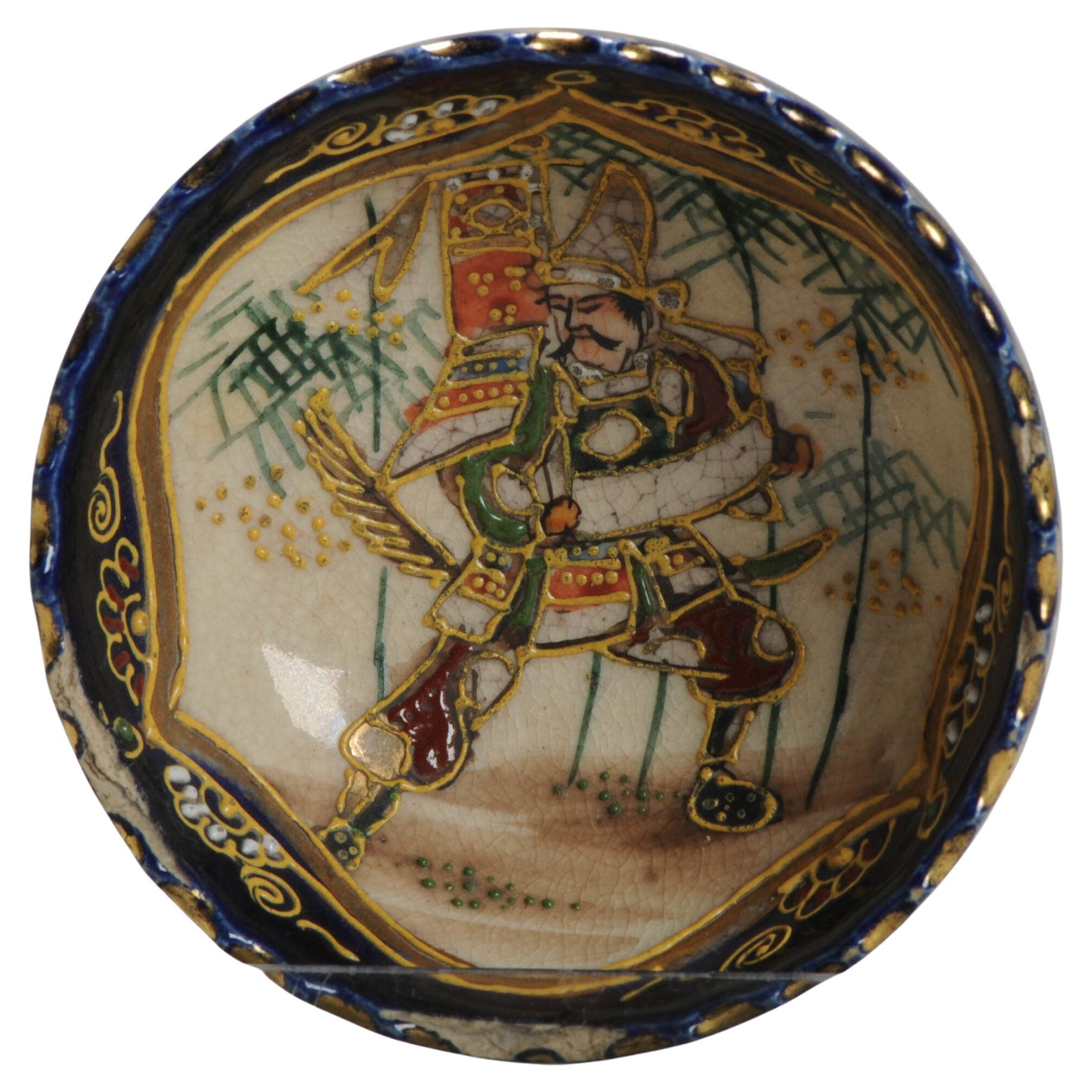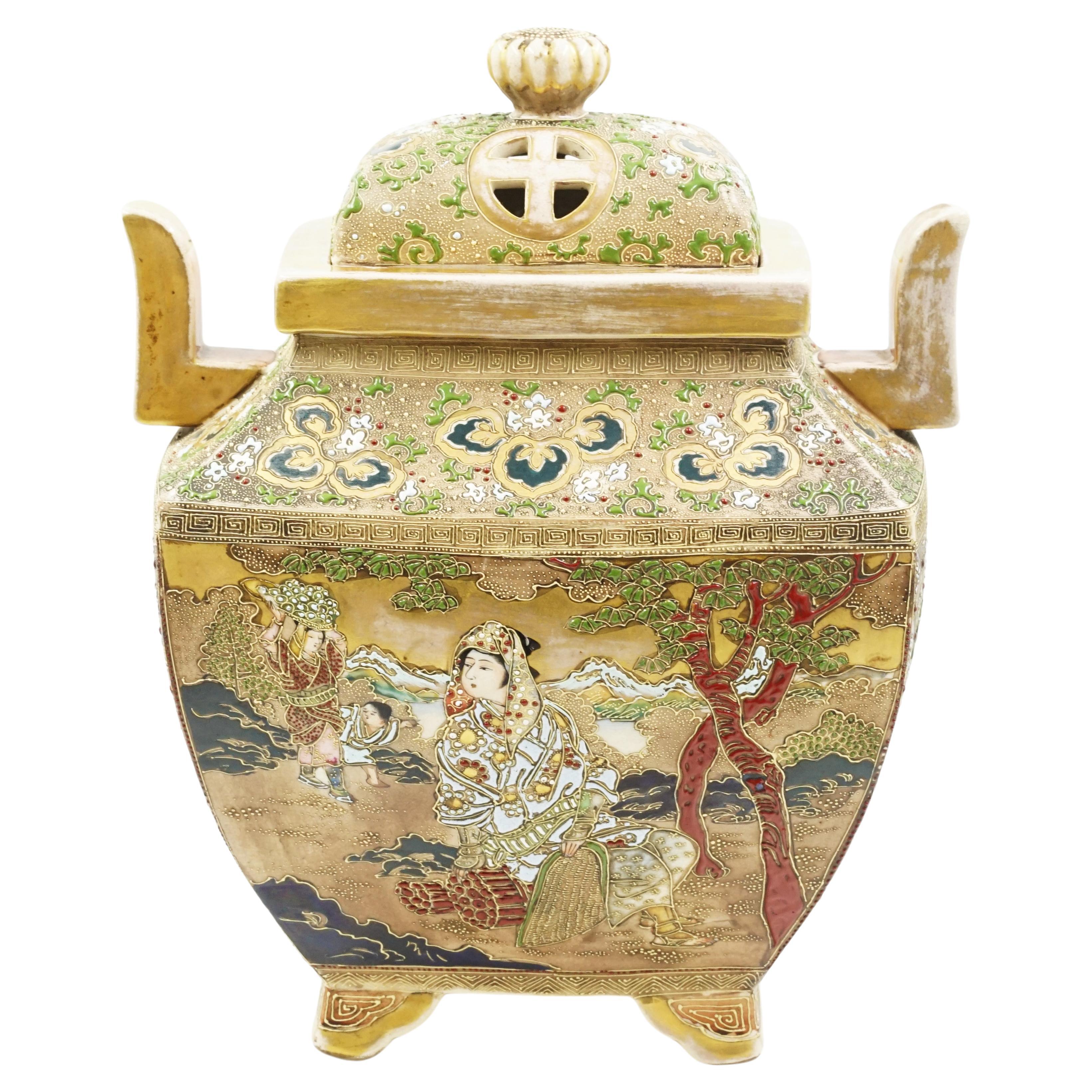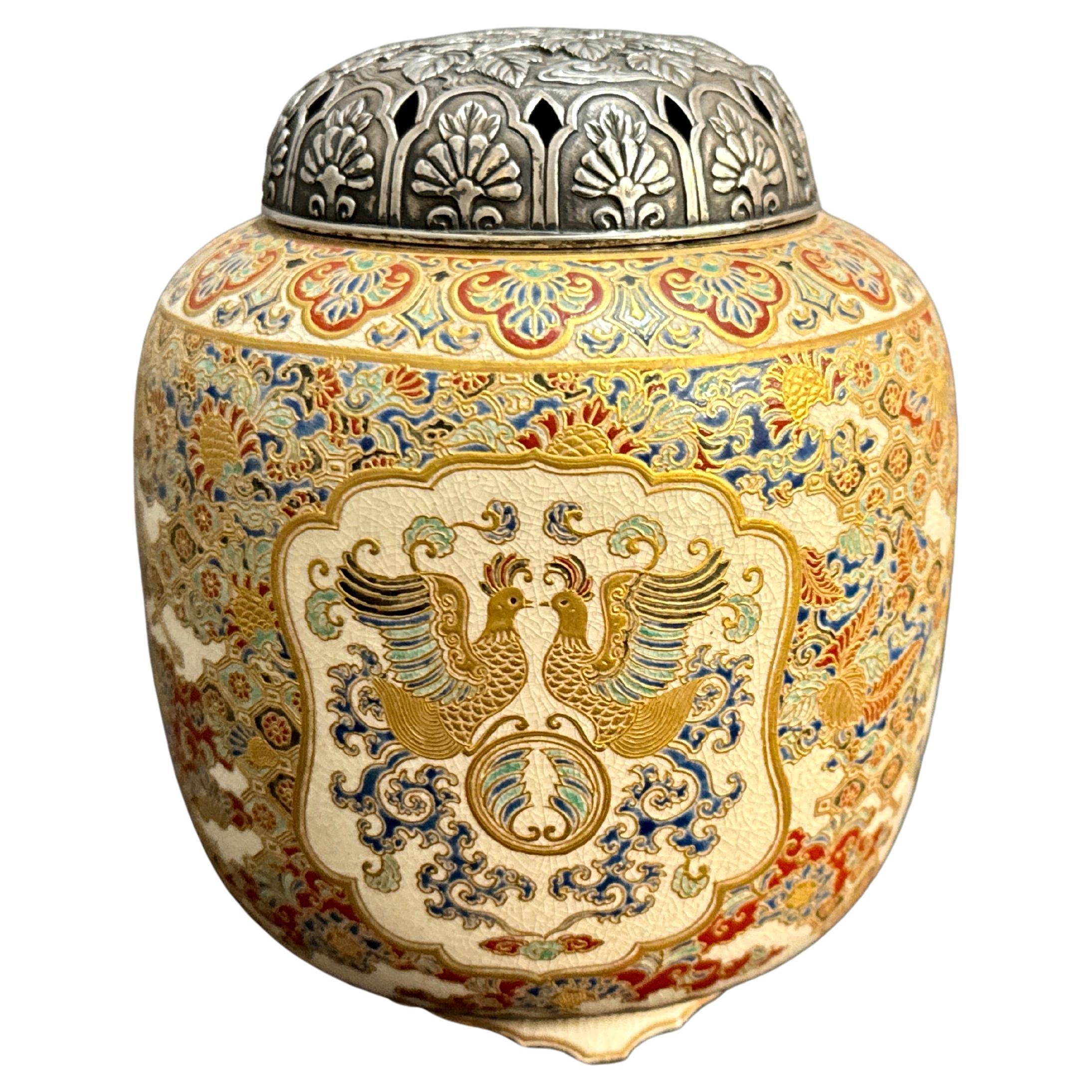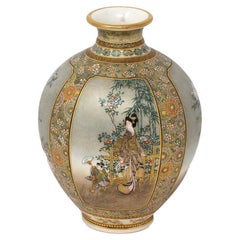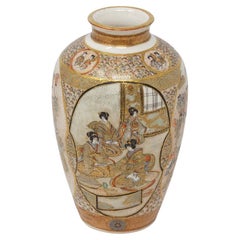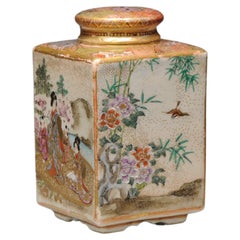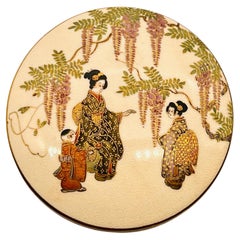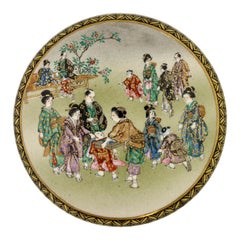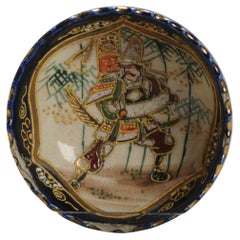Items Similar to Japanese Meiji Period (1868-1912) Satsuma Kogo Incense Box by Taizan Yohei
Want more images or videos?
Request additional images or videos from the seller
1 of 20
Japanese Meiji Period (1868-1912) Satsuma Kogo Incense Box by Taizan Yohei
$2,449.43
£1,800
€2,114.70
CA$3,365.10
A$3,756.82
CHF 1,968.52
MX$45,987.15
NOK 25,000.18
SEK 23,572
DKK 15,782.23
Shipping
Retrieving quote...The 1stDibs Promise:
Authenticity Guarantee,
Money-Back Guarantee,
24-Hour Cancellation
About the Item
DEPICTING BISHAMON ONE OF THE SEVEN LUCKY GODS
From our Japanese Satsuma collection, we are delighted to offer this Japanese Satsuma Kogo by Taizan. The Satsuma Kogo of petit circular form in two halves with a matching lid and base beautifully decorated throughout. The lid of the Satsuma Kogo has a central painting of Bishamon, one of the seven Japanese lucky gods within a black oval cartouche bordered by scrolling motifs and further painted decoration. The base of the kogo is painted with a looped pattern intercepted by small floral gold motif and a single banded pattern. The base is signed with the blind mark 帯山 for Taizan Yohei. The interior of the Satsuma Kogo is painted on both the inner lid and the base, the inner lid depicts a citron tree (also known as buddha’s hand) with a small lady beetle. The base is painted with a rectangular scroll style portrait with a central crane bird stood upon a rocky outcrop in front of a river of gold framed in a bamboo stem with foliage. The Japanese Satsuma Kogo by Taizan dates to the Meiji Period (1868-1919).
- Creator:Taizan Yohei IX (Maker)
- Dimensions:Height: 1.38 in (3.5 cm)Diameter: 2.96 in (7.5 cm)
- Style:Meiji (Of the Period)
- Materials and Techniques:
- Place of Origin:
- Period:1900-1909
- Date of Manufacture:Circa 1900
- Condition:
- Seller Location:Newark, GB
- Reference Number:Seller: PDSS1stDibs: LU6971243956232
About the Seller
5.0
Gold Seller
Premium sellers maintaining a 4.3+ rating and 24-hour response times
Established in 2019
1stDibs seller since 2022
37 sales on 1stDibs
Typical response time: 3 hours
- ShippingRetrieving quote...Shipping from: Newark, United Kingdom
- Return Policy
Authenticity Guarantee
In the unlikely event there’s an issue with an item’s authenticity, contact us within 1 year for a full refund. DetailsMoney-Back Guarantee
If your item is not as described, is damaged in transit, or does not arrive, contact us within 7 days for a full refund. Details24-Hour Cancellation
You have a 24-hour grace period in which to reconsider your purchase, with no questions asked.Vetted Professional Sellers
Our world-class sellers must adhere to strict standards for service and quality, maintaining the integrity of our listings.Price-Match Guarantee
If you find that a seller listed the same item for a lower price elsewhere, we’ll match it.Trusted Global Delivery
Our best-in-class carrier network provides specialized shipping options worldwide, including custom delivery.More From This Seller
View AllJapanese Antique Meiji Period Satsuma Vase by Kinkozan
By Kinkozan
Located in Newark, England
GLOBULAR FORM MINIATURE VASE
From our Japanese collection, we are delighted to offer this Japanese Satsuma Vase by Kinkozan. The Satsuma Vase made from earthenware pottery is potted...
Category
Antique Early 1900s Japanese Meiji Ceramics
Materials
Ceramic, Earthenware, Pottery
Antique Japanese Meiji Period (1868-1912) Satsuma Vase by Kinkozan
By Kinkozan
Located in Newark, England
Signed Kinkozan 金光山
From our Japanese collection, we are delighted to offer this Japanese Satsuma Vase by Kinkozan. The vase is potted in globular form with a tightly pinched neck and rolled top rim beautifully decorated with four highly detailed individual panelled scenes. The first a Geisha baring a gilt basket with her child playing with a fan infant of a gilt fence encompassing blossoming foliage and bamboo plants. The second scene depicts two birds, a Red Headed Japanese Wood Pigeon and a white dove in the foreground with a similar gilt fence with blossoming kiku flowers (chrysanthemums). The third scene is painted as a bustling village community with multiple figures going about their daily jobs, a central Palanquins can be seen with two figures carrying a seating figure. To the background a mountainous river landscape can viewed bordering the top left corner. The final scene appears similar to the opposing one with birds swooping high above a polychrome Japanese...
Category
Antique Late 19th Century Japanese Meiji Vases
Materials
Ceramic, Earthenware, Pottery
Antique Japanese Meiji Period Satsuma Vase by Ryozan
Located in Newark, England
MEIJI PERIOD 1868-1912
From our Japanese collection, we are delighted to offer this Japanese Satsuma Vase by Ryozan. The vase of tapered form with tightly pinched neck and flared to...
Category
Antique Late 19th Century Japanese Meiji Ceramics
Materials
Ceramic, Earthenware, Pottery
Japanese Meiji Period (1868-1912) Satsuma Earthenware Vase Taizan for Hattori
Located in Newark, England
Meiji Period (1868-1912)
From our Japanese collection, we are delighted to offer Japanese Meiji Period Satsuma Vases. The Satsuma Vase of hexagonal form with a slight waisted neck and tight rounded rim is extensively decorated with multiple figures to two large scenes. The first scene features a beach with waves to the background and a plethora of figures including multiple geisha holding traditional Japanese wagasa’s. The second scene follows on from the first with a large building in the foreground holding figures on a large platform under a pagoda roof with a pagoda building in the background and further figures in the foreground. The scenes are framed by a full detailed border with gilt shapes, flowers amongst pink shaded backgrounds and butterflies around the neck. The Satsuma Vase is unusually signed Fine Art, Satsuma Ware, Dai Nippon (Great Japan), Hattori Made, Gosuido Works, Taizan Painted. 美術, サツマヤキ(薩摩焼), 大日本, 服部造, 五スイ堂工, 對山画 and dates to the Meiji Period (1868-1912) and the turn of the 20th century circa 1905.
Satsuma ware is a type of earthenware pottery originating from the Satsuma province in Southern Kyushu, Japan’s third largest island.
Wagasa are traditional Japanese umbrellas made of washi paper attached to a bamboo frame and treated to ensure it is waterproof.
Meiji Period was an era of Japanese history that spanned from 1868 to 1912. It was the first half of the Empire of Japan, when the Japanese people began to build a paradigm of a modern, industrialised nation state and emergent great power, influenced by Western countries and aesthetics. As a result of radically different ideas, the changes to Japan were profound and it affected the social structure, politics, economy, military, and foreign relations across the board. The period corresponded to the reign of Emperor Meiji and was preceded by the Keio era and was succeeded by the Taisho era.
Cultural Art during the Meiji Period was of particular interest to the government and they overhauled the art export market which in turn promoted Japanese arts via various world’s fairs, beginning in Vienna at the world fair in 1873. The government heavily funded the fairs and took an active role organising how Japan’s culture was presented to the world including creating a semi-public company named Kiritsu Kosho Kaisha (First Industrial Manufacturing Company). The Kiritsu Kosho Kaisha was used to promote and commercialise exports of Japanese art and established the Hakurankai Jimukyoku (Exhibition Bureau) to maintain quality standards. For the 1876 Centennial International Exhibition in Philadelphia, the Japanese government created a Centennial Office and sent a special envoy to secure space for the 30,000 items that would be displayed. The Imperial Household also took an active interest in arts and crafts, commissioning works by select artists to be given as gifts for foreign dignitaries further emphasising the high quality and importance of Japanese art. Just before the end of the 19th century in 1890, the Teishitsu Gigeiin (Artist to the Imperial Household) system was created to recognise distinguished artists. These artists were selected for their exceptionally high quality wares and talent in their own industry. Over a period of 54 years Seventy artists were appointed, amongst these were ceramicist Makuzu Kozan and cloisonné enamel artist...
Category
Antique Early 1900s Japanese Meiji Ceramics
Materials
Earthenware, Pottery
Japanese Meiji Period (1868-1912) Satsuma Vase by Kinkozan
By Kinkozan
Located in Newark, England
JAPANESE SATSUMA PROCESSIONAL VASE
From our Japanese collection, we are delighted to introduce to the market this Japanese Satsuma Vase by Kinkozan. The vase with a compressed body ...
Category
Antique Late 19th Century Japanese Meiji Ceramics
Materials
Ceramic, Earthenware, Pottery
Japanese Meiji Period Satsuma Vase by Ryokuzan
Located in Newark, England
From our Japanese Satsuma Collection, we are delighted to offer this Japanese Satsuma Vase by Ryokuzan 緑山. The Satsuma vase of ovoid shape with a tapered body, circular foot rim, wai...
Category
Antique Early 1900s Japanese Meiji Ceramics
Materials
Ceramic, Earthenware, Pottery
You May Also Like
Antique 19th C Japanese Satsuma Box Matsumoto Hozan Marked Base Japan
Located in Amsterdam, Noord Holland
A small Satsuma vase, Yasuda, unidentified artist, of cuboid form with slightly domed cover, decorated with bijin alternating with landscape scenes,...
Category
Antique 19th Century Japanese Meiji Ceramics
Materials
Porcelain
$1,228 Sale Price
20% Off
A Fine Japanese Satsuma kogo (incense box) Signed by Kinkozan. Meiji period
Located in London, GB
A Satsuma circular kogo (incense box) and cover signed by Kinkozan
19th century
Finely painted in enamels and gilt, the cover with wisteria and a scene of a woman and children ...
Category
Antique Late 19th Century Japanese Ceramics
Materials
Ceramic, Porcelain
Satsuma Earthenware Covered Box, by Kinkozan
By Satsuma
Located in West Palm Beach, FL
A Satsuma Earthenware covered box,
by Kinkozan,
Japanese, Meiji period (1868-1912)
decorated in polychrome enamels and gilt over a clear, crackled glaze, delicately painted with s...
Category
Antique Early 1900s Ceramics
Materials
Earthenware
Japanese Satsuma Bowl Landscape Figural Decoration Marked, 19th Century
Located in Amsterdam, Noord Holland
Fabulous Japanese earthenware Satsuma bowl with nice decoration of a landscape with figures. Meiji period, 19th c.
Lovely piece.
Additional information:
Material: Porcelain & Pott...
Category
20th Century Japanese Meiji Decorative Bowls
Materials
Porcelain
Koro Satsuma Japanese ceramic
Located in Buenos Aires, Argentina
Koro Satsuma Japanese ceramic
Japanese glazed ceramic in various colors
Meiji Style Circa 1940 Origin Japan
It has traditional images painted on its front and back.
The purpose of th...
Category
Vintage 1940s Japanese Meiji Ceramics
Materials
Enamel
Japanese Satsuma Incense Burner, Koro, with Silver Lid, Meiji Period, Japan
Located in Austin, TX
A fantastic Japanese Satsuma incense burner, koro, with phoenix and brocade designs and a silver lid, Meiji Period, late 19th century, Japan.
The cens...
Category
Antique 1890s Japanese Meiji Ceramics
Materials
Silver
More Ways To Browse
Buddha Hand
Crane Birds
Meiji Scroll
Japanese Meiji Period Box
Antique Beetle
Black Gold Pottery
Ceramic Loops
Japanese Ceramic Birds
Satsuma Pottery
Antique Bamboo Box
Pottery Bird Signed
Japanese Satsuma Pottery
Meiji Cranes
Asian Art Bamboo Frame
Scroll Japanese Birds
Gold Crane Japanese
Satsuma Style
Asian Bird Box
